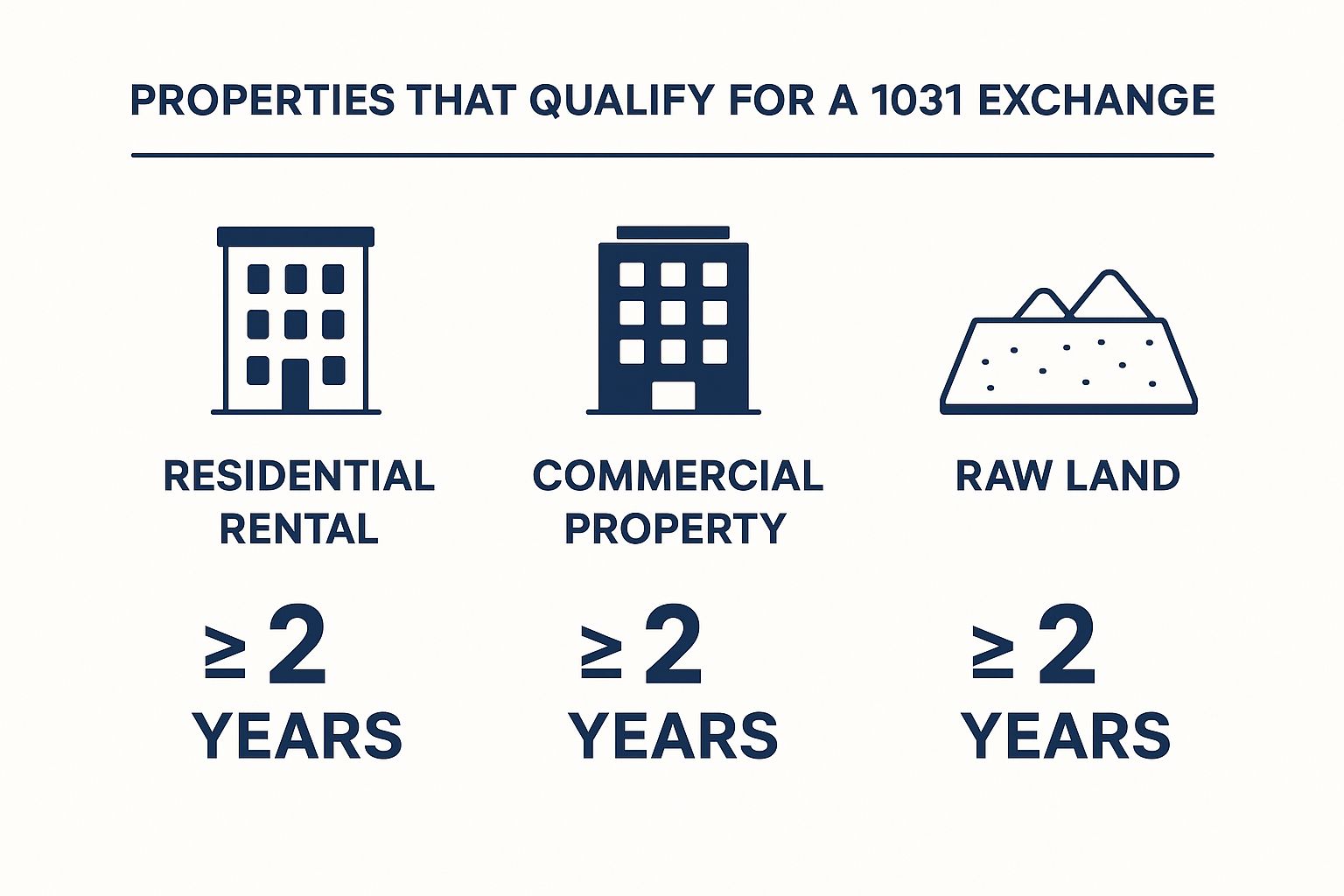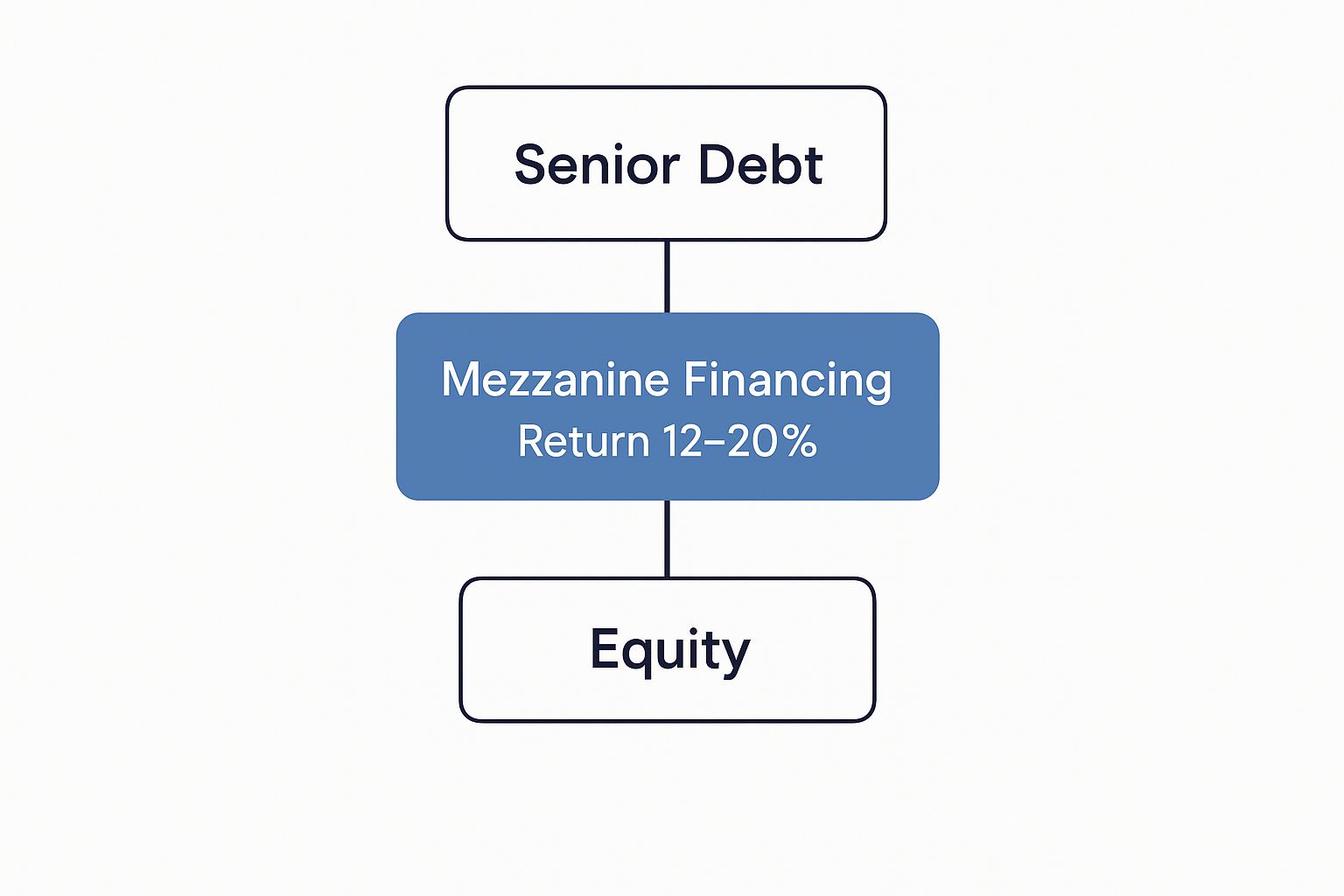Reading Time: 8 min | Good for: Novice Investors (A), Informed Principals (B)
TL;DR: Key Takeaways
What it is: A 1031 exchange allows you to sell an investment property and defer capital gains taxes by reinvesting the proceeds into a similar ("like-kind") property.
The Critical Deadlines: You have 45 days from the sale of your old property to identify potential replacements and a total of 180 days to close on the new one. These are non-negotiable.
The Golden Rule: You cannot touch the sale proceeds. A Qualified Intermediary (QI) must hold the funds between the sale and the new purchase to maintain the tax-deferred status.
The Goal: Successfully executing a 1031 exchange allows you to roll 100% of your capital into a new asset, accelerating portfolio growth and preserving wealth.
Next Step: Ready to see how a 1031 exchange could fit into your portfolio strategy? Schedule a confidential call with Stiltsville Capital to discuss your goals.
What is a 1031 Exchange, Really?
Section 1031 of the Internal Revenue Code is an absolute game-changer for real estate investors. It allows you to sell a business or investment property and postpone paying capital gains taxes by reinvesting the proceeds into a new, "like-kind" property.
Let's be clear: this isn't about tax avoidance, but tax deferral. It allows you to keep your capital working for you, compounding returns over time without the drag of a massive tax bill. For serious investors, it’s the key to:
Trading up or consolidating. You can exchange several smaller properties for a single, larger, institutional-quality asset.
Pivoting to new markets or property types. Swap a single-family rental in one state for a multifamily complex or a medical office building in a high-growth area.
Resetting your depreciation schedule. A new, higher-value property gives you a fresh depreciation basis—a powerful annual tax advantage.
Moving your investments geographically. Effortlessly shift your portfolio to capitalize on booming markets.

Novice Lens: Why it Matters Imagine you sell a property and have a $100,000 capital gain. Depending on your income and state, you might owe $20,000-$30,000 in taxes, leaving you with only $70,000-$80,000 to reinvest. A 1031 exchange lets you reinvest the full $100,000, putting significantly more capital to work in your next deal.
Who Actually Uses 1031 Exchanges?
The 1031 exchange often gets tagged as a tool for big corporations, but that couldn't be further from the truth. It's surprisingly democratic.
According to a study by Professors David C. Ling and Milena Petrova, between 10% and 20% of commercial real estate sales involve a like-kind exchange. The study also revealed that the majority of these users are smaller, individual investors, not institutional giants. This widespread use makes the 1031 exchange a cornerstone of portfolio management, keeping capital flowing efficiently through the market and encouraging continuous investment and property upgrades.
To get the most out of this tool, it helps to place it within a broader context of essential rental property investment strategies.
For the sophisticated investor, a 1031 exchange isn't just a transaction; it's a strategic pivot. It's the difference between static ownership and dynamic portfolio optimization, allowing you to continually reposition assets for maximum growth.
Think of it as a proactive step in a long-term wealth strategy. When done right, it preserves capital that would otherwise be lost to taxes, redirecting it toward bigger and better assets.
The 1031 Exchange at a Glance Key Milestones and Requirements
Milestone: Relinquished Property Sale * Requirement: Must use a Qualified Intermediary (QI) to hold the sale proceeds. You cannot have "constructive receipt" of the funds. * Who Should Care: Investors selling an investment property and intending to defer capital gains.
Milestone: Identification Period * Requirement: Within 45 days of the sale, you must identify potential replacement properties in writing to your QI. * Who Should Care: Critical for investors to have a clear acquisition pipeline before selling.
Milestone: Closing Period * Requirement: You must acquire the replacement property within 180 days of the initial sale, or your tax return due date, whichever is earlier. * Who Should Care: Investors finalizing their purchase, ensuring all rules are met for tax deferral.
Milestone: Like-Kind Rule * Requirement: Both the old and new properties must be held for productive use in a trade, business, or for investment. * Who Should Care: Ensures the exchange qualifies under IRS Section 1031. Personal residences do not qualify.
This table serves as a high-level roadmap. Navigating these milestones correctly is the difference between a successful tax deferral and a costly mistake.
Navigating Critical Timelines and Identification Rules
The entire success of your 1031 exchange boils down to two iron-clad deadlines. These aren’t suggestions from the IRS; they're non-negotiable hard stops. If you're serious about deferring those capital gains taxes, mastering these timelines is everything.
The clock starts ticking the second you close the sale on your relinquished property. From that day, you have exactly 45 calendar days to officially identify potential replacement properties. This is your Identification Period.
The 45-Day Identification Period
That 45-day window closes faster than most investors expect. Weekends, holidays—they all count. A casual email to your Qualified Intermediary (QI) won't cut it, either. Your identification needs to be a formal, signed, written notice delivered before midnight on that 45th day.
To keep things organized, the IRS gives you three ways to identify properties. The one you choose really depends on your game plan for acquiring the next asset. Most investors will find the Three-Property Rule is the most practical, but it's crucial to understand all your options before committing.
Comparison of 1031 Identification Rules
Rule 1: Three-Property Rule * How It Works: Identify up to three potential properties, with no limit on their value. * Best For: Most investors; it provides a clear primary target and two solid backups. * Consideration: This is the simplest and most common strategy for a reason—it works.
Rule 2: 200% Rule * How It Works: Identify any number of properties, but their total value can't exceed 200% of your sold property's price. * Best For: Acquiring a portfolio of smaller properties or having multiple options in a hot market. * Consideration: You need to be careful with your math. Exceeding the 200% limit can void the identification.
Rule 3: 95% Rule * How It Works: Identify any number of properties with no value limit, but you must purchase at least 95% of the total value identified. * Best For: Complex, multi-asset exchanges where you have extreme confidence in closing all deals. * Consideration: Extremely risky. If just one small property in your identified list fails to close, the entire exchange could be disqualified.
Investor Takeaway: The 45-day deadline is absolute. Our advice? Start scouting for replacements before your current property is even listed. Having a few target assets lined up prevents a last-minute scramble that almost always leads to a bad deal.
And remember, the type of property you identify matters. You have a lot of flexibility here.

This just shows how versatile the "like-kind" requirement really is. You can sell a residential rental and exchange it into raw land or a commercial building to better align with your portfolio goals.
The 180-Day Exchange Period
The second critical deadline is the 180-day Exchange Period. This is the total amount of time you have, from the day your original property sale closes, to close on the purchase of your replacement property.
Here's what trips people up: this period runs at the same time as the 45-day window. It's not 45 days plus another 180. It’s a total of 180 days, and the identification has to happen in the first 45 of them.
That 180-day clock covers everything post-identification: performing due diligence, securing financing, negotiating terms, and getting through the entire closing process. In a complex commercial deal, six months can fly by in a flash.
Let's walk through a quick example. An investor sells a warehouse on March 1st.
Identification Deadline: They have until midnight on April 15th (Day 45) to formally submit their list of identified properties.
Closing Deadline: They must close on one or more of those identified properties by August 28th (Day 180).
Any hiccup—a financing delay, a surprise on the inspection report, a title issue—puts the whole exchange in jeopardy. This is precisely why having an experienced team (your QI, agent, and attorney) isn't a luxury; it's a necessity. If you don't close in time, the exchange fails, and that sale you just made becomes a taxable event.
Choosing Your Qualified Intermediary
There's one rule in a 1031 exchange that is absolutely set in stone: you cannot have actual or constructive receipt of the sale proceeds. This is the bedrock of the entire deal, and making sure that rule is followed is the primary job of your Qualified Intermediary (QI).
Think of the QI as the independent, neutral custodian of your exchange funds. They aren't your agent or your financial advisor; they are the IRS-required third party who holds your money between the sale of your old property and the purchase of your new one. Honestly, picking the right one is probably the most critical decision you'll make in this entire process.

A top-tier QI does a lot more than just hold your cash. They are the architects of your exchange documentation, drawing up the critical agreements that keep your transaction compliant. From our own experience, a great QI is a proactive partner who spots potential issues before they become problems, not just a passive administrator who signs forms.
Questions to Ask a Potential Qualified Intermediary
The QI industry is largely unregulated at the federal level, so the responsibility for due diligence falls squarely on your shoulders. Before you sign with anyone, you need to ask some direct questions:
How are my funds secured? The only right answer is a segregated Qualified Trust Account or Qualified Escrow Account. This is non-negotiable. It keeps your money separate from their operating funds and every other client's money.
What is your fidelity bond coverage? This bond protects your funds against employee theft or fraud. Don't just ask if they have one—ask for the specific dollar amount. It needs to be substantial.
Do you carry Errors & Omissions (E&O) insurance? This is your protection if the QI makes a procedural mistake that disqualifies your exchange. Again, ask for the policy limit.
What’s your experience with transactions like mine? Have they handled complex multifamily deals, Delaware Statutory Trusts (DSTs), or improvement exchanges? A QI who mostly does single-family homes might be out of their depth on a more complicated commercial transaction.
Can you provide references from real estate attorneys or CPAs? The pros who work with QIs day-in and day-out are your best source for honest feedback on reliability and expertise.
Investor Takeaway: Never, ever choose a QI based on price alone. The few hundred dollars you might save in fees is nothing compared to the risk of losing your entire exchange proceeds or getting hit with a huge tax liability due to their incompetence.
Ultimately, the right QI becomes an extension of your professional team. They need to be responsive, detail-oriented, and able to walk you through the complexities with confidence. A great QI doesn't just process transactions; they protect them. They understand the nuances of the IRS code and act as a crucial safeguard for your capital, ensuring a smooth and successful transition from one asset to the next. This careful selection process is a foundational step in learning how to do a 1031 exchange correctly.
Understanding Like-Kind and Reinvestment Rules
The term "like-kind" is easily one of the most powerful—and misunderstood—parts of a 1031 exchange. A lot of investors hear it and immediately think they have to swap a duplex for another duplex, or a retail strip for one just like it down the street.
Fortunately, the reality is far more flexible.
The IRS actually defines "like-kind" by the nature or character of the property, not its specific grade or quality. This is where the strategic possibilities really open up for savvy investors. Essentially, any real property you hold for investment or business purposes is considered like-kind to any other real property held for the same reason.
The True Meaning of Like-Kind
This broad definition is what makes the 1031 exchange such a dynamic tool for repositioning a portfolio. It means you can get creative.
For example, you could:
Exchange a piece of raw, undeveloped land for a fully-leased multifamily apartment building.
Swap a portfolio of single-family rentals for a passive interest in an institutional-grade medical office building.
Trade a warehouse in one state for a retail center in a high-growth Sunbelt market.
The only real catch is that both the property you sell and the property you buy must be for investment or business use. You can’t, for instance, exchange your personal residence or a vacation home that doesn't pass strict rental-use tests. This incredible flexibility allows you to pivot your entire strategy—geography, asset class, and management style—all without triggering a massive tax bill.
Investor Takeaway: Don't get boxed in by the idea of a direct, one-for-one swap. The "like-kind" rule is your ticket to completely reposition your real estate holdings to match your new goals, whether that’s moving from hands-on assets to passive investments or from raw land to cash-flowing properties.
The Three Pillars of Reinvestment
While the like-kind rule gives you plenty of room to maneuver, the reinvestment rules are the complete opposite—they're rigid. To get the full tax deferral and avoid any taxable "boot," you have to nail three specific requirements. If you fall short on even one, you'll be looking at a taxable event.
To defer 100% of your capital gains tax, you absolutely must:
Acquire property of equal or greater value. The total purchase price of your new property (or properties) has to be at least what you sold the old one for.
Reinvest all of the equity. Every single dollar of cash proceeds from your sale must go into the purchase of the new property.
Replace the debt. You must take on the same amount of debt (or more) on the new property as you had on the one you sold. You can do this with a new loan or by adding more of your own cash to the deal.
Think of these as the three legs of a stool. If any one of them is shorter than it was before, the whole exchange becomes unstable and partially taxable. This is, without a doubt, one of the most common places where investors make expensive mistakes.
Deal Lens Example: The Math Behind Taxable Boot
Let's walk through an illustrative example to see how this plays out in the real world. Imagine you sell an investment property with these numbers:
Sale Price: $2,000,000
Mortgage Paid Off: $800,000
Cash Equity: $1,200,000
You then find a great replacement property, and the purchase looks like this:
Purchase Price: $1,800,000
New Mortgage: $700,000
Cash Invested: $1,100,000
At a quick glance, it might feel like a win. But let's run it through our three reinvestment rules:
Value Rule: You sold for $2M but only bought for $1.8M. You have $200,000 of "trade-down boot."
Equity Rule: You started with $1.2M in equity but only put $1.1M into the new deal. You have $100,000 of "cash boot" coming back to you.
Debt Rule: You paid off an $800K mortgage but only took on a new $700K mortgage. That’s a $100,000 shortfall in debt.
In this situation, you’d owe capital gains tax on the largest of these shortfalls—the $200,000 trade-down boot. This is exactly why careful planning with your CPA and Qualified Intermediary is so critical. You need to account for every dollar to protect your tax deferral.
For investors looking for a more hands-off way to execute an exchange, you can check out our guide on using 1031 exchange funds for streamlined investing.
Advanced Strategies and Common Pitfalls
Once you've got the basics of a standard 1031 exchange down, it’s time to look at more advanced structures. These aren't your everyday tools, but in the right situation, they open up possibilities a simple delayed exchange just can't touch.
Of course, with more flexibility comes more complexity—and more chances to make a costly mistake. For any serious investor, understanding both the advanced plays and the common traps is key to really making Section 1031 work for you.

Sophisticated Exchange Structures
In a hot market where good replacement properties are flying off the shelves, selling your property first puts you on the back foot. This is where the Reverse Exchange shines. It flips the script, letting you buy your new property before selling your old one.
Your QI sets up a special entity, an Exchange Accommodation Titleholder (EAT), to acquire and "park" the new property for you. This lets you pounce on a great opportunity immediately. From there, you have 180 days to sell your original property and finish the exchange. It's a game-changer, but be prepared for higher fees and trickier financing.
Another powerful option is the Improvement or Build-to-Suit Exchange. This lets you use your exchange funds to build a new property or pay for major renovations on one you acquire. The QI holds the money and pays construction costs as they come up, rolling the value of the improvements into the final price to help you meet your reinvestment target.
Passive Investing with Delaware Statutory Trusts
For investors looking to step back from the day-to-day grind of property management, the Delaware Statutory Trust (DST) is a fantastic solution. A DST allows a group of investors to pool their 1031 funds to buy fractional shares in large, institutional-grade properties.
Advanced Lens: A DST can solve multiple 1031 challenges at once. It provides access to high-grade assets, satisfies identification rules with a single purchase, and eliminates day-to-day management burdens, converting active real estate ownership into a truly passive investment.
These are professionally managed portfolios that give you diversification across different property types and locations—something that’s tough to achieve on your own. If this sounds interesting, our investor's guide to the Delaware Statutory Trust goes into much more detail on how these work.
Risk & Mitigation: Common 1031 Traps
Risk: Failing to Identify a Replacement Property in Time. * Mitigation: Begin your search for replacement properties before you list your current property for sale. Have backup options identified and vetted to avoid a last-minute scramble.
Risk: Receiving Taxable "Boot". * Mitigation: Work closely with your CPA and QI before closing both transactions to model the flow of funds. Ensure your new property's value, equity, and debt are equal to or greater than the property you sold.
Risk: Mishandling Partnership Exchanges. * Mitigation: The same "taxpayer" must sell and buy. An individual partner cannot simply exchange their share. This requires complex structuring (like a "drop and swap") planned with legal counsel months in advance.
Risk: Financing Delays on the Replacement Property. * Mitigation: Engage with lenders who are experienced in 1031 transactions and understand the tight deadlines. Secure a pre-approval or a firm letter of intent early in the 180-day period.
Common 1031 Exchange Questions, Answered (FAQ)
Every 1031 exchange journey is unique, but many of the same questions pop up along the way. We've heard just about all of them from investors over the years. Let's tackle some of the most common ones to give you the clarity you need to move forward.
Can I Use 1031 Funds to Fix Up My New Property?
Yes, but you have to do it the right way. This is what's known as an Improvement or Build-to-Suit Exchange.
You absolutely cannot just take the exchange proceeds and pay a contractor yourself. Doing that would be a classic "constructive receipt" violation, which instantly blows up your exchange and creates a taxable event. Nobody wants that.
Instead, the plan for the improvements has to be identified before you close. Your Qualified Intermediary (QI) holds the funds and pays them out as construction milestones are hit, all according to a predefined agreement. This structure rolls the value of the improvements into the final purchase price, which is a massive help in hitting your reinvestment targets.
What Happens if I Can’t Find a Replacement Property in 45 Days?
This is the one that keeps investors up at night, and for good reason. If you don't formally identify a potential replacement property—in writing, to your QI—within the 45-day window, the exchange is over. It fails.
There are no extensions. No exceptions. It doesn’t matter if your financing fell through or if the market is tight.
Once that deadline passes, your QI has no choice but to return the sale proceeds to you. The moment that cash is back in your hands, the sale of your old property becomes fully taxable. You’ll be on the hook for capital gains and depreciation recapture for that tax year. This is precisely why savvy investors have a list of potential properties scouted before their relinquished property even sells.
Can I Do a 1031 Exchange on My Primary Residence?
The short answer is no. A 1031 exchange is strictly for property held for investment or used in a trade or business. Your primary home, a personal vacation spot, or any property you mainly use yourself simply doesn't qualify.
But don't despair—your primary home gets its own powerful tax break under Section 121 of the tax code. This allows an individual to exclude up to $250,000 of capital gains (or a whopping $500,000 for a married couple) from taxes, provided you meet the ownership and use tests.
It's interesting to see how these rules evolved. The concept first showed up in the Revenue Act of 1921 but was officially codified as Section 1031 in 1954. The real game-changer was the Starker v. United States case in 1979, which legitimized delayed exchanges and created the modern Qualified Intermediary system we rely on today. You can take a deeper dive into the evolution of 1031 exchange regulations on 1031crowdfunding.com.
At Stiltsville Capital, we believe well-structured real assets are a prudent, resilient component of any long-term wealth strategy. We specialize in helping accredited investors navigate these complexities to build durable portfolios through institutional-quality real estate.
If you're considering a 1031 exchange and want to explore passive, institutional-grade replacement options, we're here to help.
Information presented is for educational purposes only and does not constitute an offer to sell or a solicitation of an offer to buy securities. Any offering is made only through definitive offering documents (e.g., private placement memorandum, subscription agreement) and is available solely to investors who meet applicable suitability standards, including “Accredited Investor” status under Rule 501 of Regulation D. Investments in private real estate involve risk, including loss of capital, illiquidity, and no guarantee of distributions. Past performance is not indicative of future results. Verification of accredited status is required for participation in Rule 506(c) offerings.












